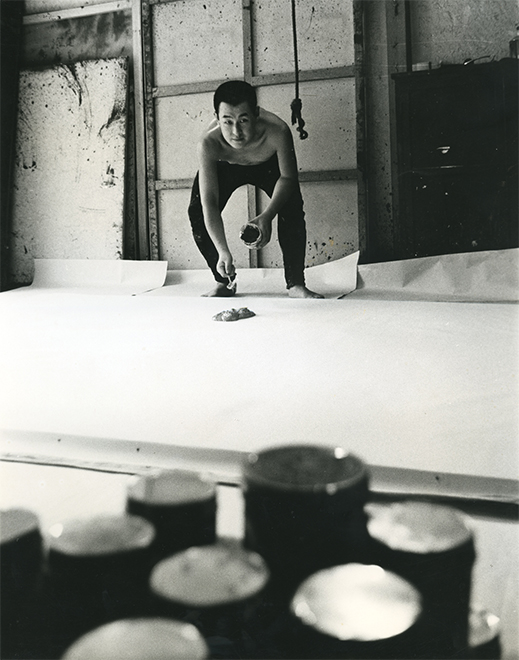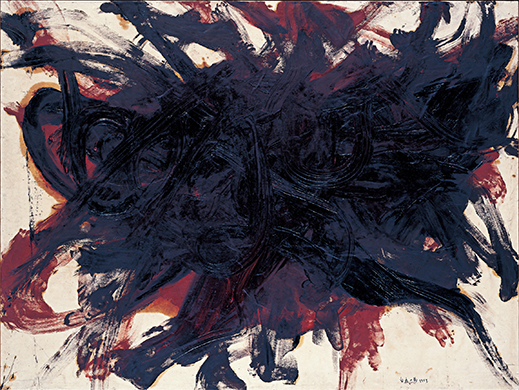 |
|
Here and There introduces art, artists, galleries and museums around Japan that non-Japanese readers and first-time visitors may find of particular interest. The writer claims no art expertise, just a subjective viewpoint acquired over many years' residence in Japan.
|
|
 |
|
|
 |
 |
Get on the Good Foot: Kazuo Shiraga at Opera City
Alan Gleason |
 |
Installation view of Kazuo Shiraga: A Retrospective. In the center is Mitsuju (Esoteric Mantra), 1975, Amagasaki City. Photo by Tadashi Ono |
"Action painting" tends to conjure up images of Jackson Pollock splattering his canvas with random globs of paint. Kazuo Shiraga (1924-2008) is sometimes rather glibly referred to as Japan's Jackson Pollock, but while the two artists' styles have superficial similarities, Shiraga's technique and motives were decidedly his own. His work also owes more to traditional Japanese painting and calligraphy than may meet the eye. The Shiraga retrospective currently at Tokyo Opera City Art Gallery offers a thorough look at his harrowing oeuvre.
The exhibition is dominated by the fierce monumental abstracts, mostly oils on canvas, that made Shiraga famous. All blacks and blood-reds with a few dollops of blue and green, these works defy interpretation, though some carry titles with literary or religious references that may actually be misleading (more on this later). There are no figurative gestures to be seen in these great swathes of paint, and the psyche is quickly overwhelmed, as if lost in a labyrinth of monstrous Rorschach tests.
|
 |
|
|
|
Shiraga in his atelier, 1960, scooping paint from a can onto the canvas for a foot-painting session. The rope he swings from dangles in back. Courtesy of Amagasaki Cultural Foundation
|
For most of his career, Shiraga eschewed brushes, preferring the direct energy transfer afforded by painting with his hands and feet. He is best known for his foot paintings, which he produced by clutching a rope suspended from the ceiling so that he could slide his bare feet freely through paint poured on a canvas spread across the floor. Film footage of Shiraga in action (you can see a snippet here) shows how much physical and emotional energy he invested in this process, which appears entirely spontaneous. But in the artist's own words, "hanging from a rope and painting with my feet is not so much to create a fully automatic work as to make a record of high-velocity action on the canvas. I do not intend to rely on chance effects." (Quoted in Giichi Nakamura, "A Beast of Action," originally published in Bijutsu Techo, April 1963; translated by Christopher Stephens for the catalog of the 1918 exhibition Shiraga Kazuo: The Water Margin Hero Series.)
|
 |
|
|
|
Difficult Voyage, 1949, Amagasaki City
|
Indeed, Shiraga's evolution into an abstract-expressionist action painter was gradual and deliberate. Born into a family of kimono merchants in Amagasaki, Hyogo Prefecture, he was a sensitive child who early on exhibited a flair for painting. Fortunate to come of age just as World War II was ending, he received a proper art education, studying Nihonga (Japanese-style painting) but switching to Western painting due to his love of oils. His early works are modernistic but figurative and surprisingly placid. By the early fifties, however, inspired by the example of the Fauvists, he was painting increasingly abstract works and experimenting with alternatives to the brush, which he found cumbersome. By 1952 he was using handmade spatulas, then dispensed with these in favor of his bare hands and fingernails. He also began placing large canvases on the floor, then found he needed to walk on them to reach the center. This, he explains, is how he arrived at foot painting. To avoid slipping on the paint he suspended a sturdy rope from the ceiling, which he clung to while sliding across the canvas.
 |
|
Untitled, 1957, oil on paper, Toyota Municipal Museum of Art |
An encounter with the Osaka-based Gutai movement and its charismatic leader, Jiro Yoshihara, reinforced Shiraga's inclination toward action painting. Yoshihara, who exhorted his disciples to "do what no one has done before," invited Shiraga to join Gutai in 1955, and he soon became one of the group's most prominent members. Initially Shiraga made a name for himself with radical performance pieces like Challenging Mud (1955), in which he writhed around naked in a pool of muck, and sanguinary works like Red Fluid (1956), a glass case filled with cow livers floating in red water. However, he soon decided to concentrate on foot paintings with a palette dominated by blacks, blues, and the bloodiest red of all, crimson lake.
|
 |
|
|
|
Chibosei Somonshin (Savage Star, God of Death), 1961, Hyogo Prefectural Museum of Art (Yamamura Collection)
|
The high-water mark of Shiraga's foot-painting output came in the early 1960s, when he produced over 100 works in the space of five years on commission from a Paris gallery, naming each after one of the 108 mythical heroes in the Ming-dynasty Chinese epic The Water Margin. The tale had been a favorite of Shiraga since childhood and he spoke often of wishing to emulate its characters, magical beings with superhuman powers but all too human foibles. Since Shiraga had previously left most of his works untitled (his mentor Yoshihara frowned on titling), the exotic flavor of this series' titles enhanced its visibility, and in some strange way legitimacy, in the eyes of critics.
Tenkusei Kyusempo (Flight Star, Impatient Vanguard), 1962, Hyogo Prefectural Museum of Art |
Shiraga, however, has explained that his naming process was just a way to keep track of the series and do it in a more mnemonic way than mere numbering. "I thought it would be good to name them after the heroes in The Water Margin . . . I just assigned the names arbitrarily according to how the pictures looked." Hence a snake-like form in one painting inspired him to title it Savage Star, Double-Headed Serpent after the character so named in the epic.
In the mid-sixties Shiraga began working with a spatula or squeegee again, producing marginally more structured works dominated by great concentric swirls. Then, in 1971, after a prolonged hiatus in his artistic output, Shiraga entered Enryaku-ji, the temple atop Kyoto's Mt. Hiei, to undergo religious training in the Tendai school of Esoteric Buddhism. This appears to have rekindled his motivation to paint, and the titles of his works, many featuring mandala-like circular forms, began to reflect Buddhist themes.
 |
|
Kanryu (Penetrating Flows), 1973, Tokyo Opera City Art Gallery |
Yoshihara's death in 1972 and the subsequent dissolution of Gutai seem to have further distanced Shiraga from the Fauvist ferocity of his early-sixties work, though later in life he would return to foot painting with verve: "Having expressed a world of tranquility with the circles, I was seized by the impulse to slide my feet across the canvas again." As late as 2000 he added two more paintings to his Water Margin series, completing the entire set of 108 for the 108 heroes. Shiraga was still painting with his feet in 2007, the year before his death at 83.
Gunjo (Ultramarine), 1985, Board of Education, Amagasaki City (Amagasaki High School) |
Though Shiraga's prodigious early-sixties output of Water Margin-titled paintings gave him global cachet, an argument can be made that he did his best work in the seventies when he was immersed in his Buddhist practice. The squeegee-rendered circles and semicircles of works like Abiraunken and Mitsuju have a core of quietude, like the eye of a hurricane, that is lacking in the frenetic fervor of the earlier works. Contemplating them induces a state of serene incomprehension.
Abiraunken (Chanting the Mantra of Garbhadhatu Dainichi-nyorai [Vairocana]), 1975, Hyogo Prefectural Museum of Art |
Unfortunately the show provides a bare minimum of captions, although an exhaustive biographical timeline and some videos of Shiraga at work greet the visitor at the tail end of the exhibits (all, however, are in Japanese).
All works shown are by Kazuo Shiraga, and all are oils on canvas except where otherwise noted. All images are courtesy of Tokyo Opera City Art Gallery.
 |
| Kazuo Shiraga: A Retrospective
|
| 11 January - 22 March 2020 |
| Tokyo Opera City Art Gallery |
Tokyo Opera City 3F, 3-20-2 Nishi-Shinjuku, Shinjuku-ku, Tokyo
Phone: 03-5777-8600 (NTT Hello Dial)
Open 11 a.m. to 7 p.m. (to 8 p.m. on Fridays and Saturdays); entry up to 30 minutes before closing
Closed Mondays (Tuesday if Monday is a public holiday), year-end/New Year holidays, and exhibition changeover and maintenance days
Access: 5-minute walk from the east exit of Hatsudai Station on the Keio New Line (one stop west of Shinjuku Station)
Note: Tokyo Opera City Art Gallery is temporarily closed until 16 March as a preventive measure against the spread of the coronavirus. Please check the website for updates.
|
|
|
|
| |
 |
Alan Gleason
Alan Gleason is a translator, editor and writer based in Tokyo, where he has lived for over 30 years. In addition to writing about the Japanese art scene he has edited and translated works on Japanese theater (from kabuki to the avant-garde) and music (both traditional and contemporary). |
|
|
|
|
|
|
|
|
|
 |
|